During ICFF 2014, GBlog met with Giulio Iacchetti at Alessi’s booth Wanted Design NYC. The event was held in the Terminal Stores building on 11th Avenue, and GBlog spoke with Iacchetti and a translator right in the middle of the tunnel. Surrounding us, there stood a display of Iacchetti’s latest work for Alessi, the Noè Collection of playful and intuitive wine tools, as well as many more home accessories by established and young designers alike.
The Noè Collection is named after the Biblical Noah, who, in addition to bringing animals on his ark, is said to have fermented the first wine. Celebrating the grape from beginning to end, the series provides everything one needs to store, open, pour, and preserve wine. Each of the designs takes after a unique aspect of the wine drinking experience. The bottle holder echoes the form of a bunch of grapes, the champagne opener mirrors the shape of a bottle, the drop ring resembles a diamond ring, and the cap looks much like a cork. As a collection, Noè immerses the user in the world of wine with age-old symbolism and functional simplicity.
GBLOG: You have recently done the Noè collection and also the Orte Collection of gardening tools. Which of the two would you say reflects more of your own personality?
IA&A: It is very important when you work with different brands, different companies, to work in a way that the personality of the company stands out more than your own personality.
GBLOG: What was the inspiration for the Noè collection?
IA&A: First thing is that these are objects that are designed to serve…to do a service to wine…not to serve wine, to be a service for wine, not only for the actual act of drinking…but to enhance the ritual of wine and the tradition and the heritage of wine. So, really, these are objects that are meant to be a sort of homage to wine in that perspective. The project was developed around the movements, the gestures, that you do when you interact with wine. You open it manually. The hand is in the ritual of wine with the opening, the serving, and the closing of the bottle of wine. So, there are all these different objects in the collection so that you use your hands when you serve wine and enjoy wine.
GBLOG: What was the thinking behind the drop ring, which seems to be inspired by a diamond ring?
IA&A: The inspiration was really in the name itself, of the ring. He was designing the drip stop ring, so it’s a ring. Immediately, he thought of the neck of the bottle as a finger, and the ring is a ring, and, when you have a ring, you also have a jewel…. At the same time, it also symbolizes the marriage between the what we obviously enjoy with a glass of wine and the wine itself, the bottle. It’s the wedding, the symbol of the wedding, between the person and the wine.
There’s also another element in this project, which is an element that is very common to a lot of examples of Italian design and examples of Giulio and Alessi’s objects, which is a sense of humor. Humor is sometimes a very important element of the connection that a user, a consumer, has with an object. It’s one of the things that make the object and the consumer interact. In this particular case, the humor also stands for the fact that when you present this ring with a jewel in its case, it’s just like when you are proposing to your fiance…So there is a lot of this humor, and it’s also a very important aspect of design and life.
GBLOG: What was the reason for using thermoplastic resin for the bottle holder?
IA&A: The choice of material is always one with the project and the cost. When you start thinking of an object and the project, the material immediately becomes part of the initial cost. In this particular case, the thing that was really guiding the choice was the need, because it’s a modular concept, it’s elementary, to be lightweight but at the same time also very resistant. The need for something sturdy and lightweight and the fact that it’s modular are what dictated the choice of the plastic resin.
GBLOG: You’re obviously a great Italian designer and also a traveler. From your travels, is there anything in particular that you are planning to bring back to Italy?
IA&A: From this specific travel or any travel in general?
GBLOG: From travel in general.
IA&A: One of the main characteristics of a designer, a good designer, is the porosity…. It’s an idea of absorbing like a sponge. It’s being where you are and this attitude towards taking what you see and what surrounds you like a sponge: these people, these visuals, and all these concepts that are new and that you can bring with you to your work, this openness, really.
GBLOG: You’ve been doing some more local work as well. With Internoitaliano, the design and the manufacturing is all done in Italy. For you, why is it important to you that a product be manufactured in Italy rather than anywhere else in the world?
IA&A: The importance is of the manual work and of the artisan, which in Italy has always been a quality that is always very important. There are some aspects of an artisan, the craftsmanship, in Italy that nobody else has in the world.
With Giulio, it is important especially in this moment when there’s a recession in Europe and Italy. We’re getting out of it, but we’re still in a very difficult moment from an economic and financial point of view. It’s very important to celebrate and bring back to the center of these people who are artisans. For him, it was a question of justice, even before design, to bring it back, to bring those people to the center of attention and the spotlight, to be celebrated and to be respected.
GBLOG: Lastly, what does the “Italian way of living” mean to you?
IA&A: For Giulio, the most important thing of Italian living is the ritual. The drinking, the glass of wine, we call it aperitivo, which is actually another project of Giulio’s, which is our version of happy hour, when you go out for an aperitivo with your friends or when you go out for dinner with your friends or when you gather your family at the table. All of these things are rituals. For Giulio, observing these rituals and how we interpret these rituals visually is very important. That is the Italian lifestyle, and it’s important to designing.
GBLOG: Very fitting for this last collection.
IA&A: And for all of the work that Giulio does. Both of the works that you mentioned are great examples of that. Also, the work that he did for Moleskine is a great example. I think it permeates everything that he does.










